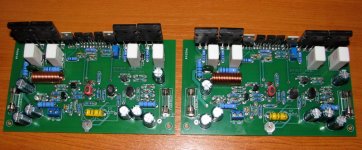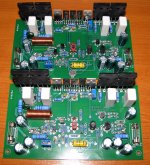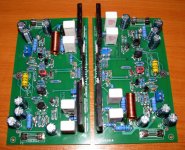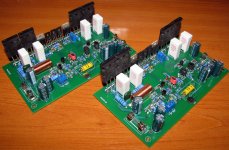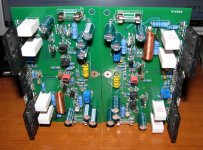Tekko, thanks, that is reassuring. IIRC, I have the MJL3281A/MJL1302A sets in my parts bin.
MJL3281A/MJL1302A are excellent transistors for the job - Better performing than most other types, but this would be based purely on my own opinion and experience.
its too early...
As Harrison said a good amp. should be able to adapt.every listenner have different taste.some like rock other like jazz and etc..we all give colloration to sound by using preamps and tone control.if the amp.cant give us want we want then it is a bad amp. give the user the freedom,let them use whatever equiptment they have and also the type of music they like, to associate with the SYMEF amp..Then we take all their feedbacks. so far its 2-0 in favor of SYMEF.
regards,
joel
As Harrison said a good amp. should be able to adapt.every listenner have different taste.some like rock other like jazz and etc..we all give colloration to sound by using preamps and tone control.if the amp.cant give us want we want then it is a bad amp. give the user the freedom,let them use whatever equiptment they have and also the type of music they like, to associate with the SYMEF amp..Then we take all their feedbacks. so far its 2-0 in favor of SYMEF.
regards,
joel
it's the result of the demands made by real speakers on real amplifiers.Is this known scientific fact or just a personal arithmetical preference.
"A 8ohm capable amplifier, must be able to deliver at least two times resistive current demand and preferably three to four times that resistive demand from a reactive speaker reproducing fast transients."
There are many commentators, some of whom publish tests with results, that state and show that transient currents demanded by speakers exceed that demanded by the nominal resistive load.
There are approximate simulations and modeling that confirm that more current can be demanded by speakers than a simple resistive equivalent load.
There is a general consensus that a reasonable target be at least twice the current of the nominal resistor.
I have read, on this Forum, of a series of tests that show that a range of speakers can demand five times the current.
I now design for three times as a matter of course. This really affects the driver and pre-driver stages. A two stage output cannot deliver the peak currents, if severe reactance speakers are to be driven properly.
I will conclude by answering your first question.
It is a known fact.
Last edited:
Hi Sondidos,
In my opinion, if one wants the exact same sound character experienced by others that built and commented on this thread (or any other thread for that matter), the exact same components need to be used as the other constructors did.
Nico, yes, I loathe throwing a whole mix of different ingredients into the mix. My wife is Peruvian and I try my best to make approximations of her favorite dishes from her childhood. I come close at times or sometimes my interpretation betters her memories of her favorite foods, but it is always different from the original.
Sonidos,
absolutely, the "best" amplifier or speakers or sound only exists in the mind of the listener. That is why I am so keen to see the formula that can predict the likes and dislikes of people.
I have absolutely nothing against Onaudio's amplifier. I only remain curious regarding what makes this amplifier so differently better from identical topologies or different topologies.
The revealing of this "formula" is the only reason I am lurking around here not the amplifier, it is completely ordinary.
absolutely, the "best" amplifier or speakers or sound only exists in the mind of the listener. That is why I am so keen to see the formula that can predict the likes and dislikes of people.
I have absolutely nothing against Onaudio's amplifier. I only remain curious regarding what makes this amplifier so differently better from identical topologies or different topologies.
The revealing of this "formula" is the only reason I am lurking around here not the amplifier, it is completely ordinary.
If pressed disassemble this
AIR CORE INDUCTORS from Parts Express ship same day and come with 45 day money back guarantee. Free Shipping Available. Order free 10,000 product catalog.
Do for 1uh.(18 turns,16awg-thickness in 1/2" diameter)
I am thinking of unwiding one of these
INDUCTOR,TOROID,VERTICAL,10.0 uH,20.0 IDC,0.005 OHM and winding it on my own. The wire does look kind of wrinkly tho :/. Needs to be straightened more.
The inductor that I have is 18AWG and I am using these two calculators.
Calculator 1
Calculator 2
They both differ a bit in terms of windings and what not but I can seem to get the 18 turn ration on the 16AWG
for 18AWG using this calculator got this (1in coil lenght)
Inductance (L):= 1uh
Coil Inner Diameter (d): .5in
Coil Length (l): 1in
Wire Gauge: 18AWG
Number of Turns (N): 15
Turns per Layer: 23.92
Number of Layers: 0.63
Coil Outer Diameter (D): 0.58
Wire Diameter: 41.8mils
Wire Length: 1.91ft
DC Resistance (R): 0.01R
P = I^2 * R
where I is the DC current.
If you use AC current then you must use Irms for your modeling to be correct.
If you use a sinewave as the test signal and you find it easier to measure an accurate Ipk rather than Irms then that Ipk must be converted back to Irms using the Ipk = Isinewave * sqrt(2).
So back to that 20Apk value.
An 150W into 8ohm capable amplifier will deliver 150W into 8r0 from 49Vpk (=34.6Vac) while meeting a current demand of 6.1Apk (=4.3Aac).
A 8ohm capable amplifier, must be able to deliver at least two times resistive current demand and preferably three to four times that resistive demand from a reactive speaker reproducing fast transients.
That three times the 6.1Apk comes out at 18.3Apk and four times comes out at over 24Apk.
Good explanation! thanks for that. It looks like a good general rule of thumb for accounting for those transients without looking at it in a model or measuring it. Hopefully my SYMEF wont blow up lol
I am trying to model a power supply for it and how does this cap look? Wil it suffice. I am worried about the voltage and current ratings might not be sufficient.
565-2698-NDESMH630VSN103MR50TCAP ALUM 10000UF 63V 20% SNAPSMHUnited Chemi-Con10000µF63V±20%2000 Hrs @ 85°C-40°C ~ 85°CGeneral Purpose5.49A
or this is better
338-2677-ND380LX103M080A052CAP ALUM 10000UF 80V 20% SNAP380LXCornell Dubilier Electronics (CDE)10000µF80V±20%3000 Hrs @ 85°C-40°C ~ 85°CGeneral Purpose---Through HoleRadial, Can - Snap-In1.378" Dia (35.00mm)2.047" (52.00mm)0.394" (10.00mm)-Bulk19217.56000
@ qty
1
or even better at cost
An externally hosted image should be here but it was not working when we last tested it.
P10031-NDECE-T1KP103EACAP ALUM 10000UF 80V 20% SNAPT-UPPanasonic - ECG10000µF80V±20%3000 Hrs @ 85°C-40°C ~ 85°CGeneral Purpose6.38A33.0 mOhm-Through HoleRadial, Can - Snap-In - 4 Lead1.378" Dia (35.00mm)2.480" (63.00mm)0.886" (22.50mm)-Bulk488110.18000@ qty
1
Last edited:
The revealing of this "formula" is the only reason I am lurking around here not the amplifier, it is completely ordinary.
Maybe the formula is the more mumbo jambo you tell people, ie how good it is the better it sounds. Dx also uses this formula.

I undertsood this formula as a way to make other people work for yu, design PCB, do the testing, listening.... Electronically there is no formula, even simulation was not done properly.
 FORMULA!
FORMULA! 





Still we have to admit the whole bunch of threads based on this brain stimulating formula are amusing, a lot of fun reading the feedbacks.

Good research Digger,
You plan to spend less than a dollar on that coil Ingenious.
Ingenious.
The caps look wow. The lower the resistance the better, the more current the better, the more the hours the better, the more the legs the better. Hard choice to make, now what will it be?
Look at post #425. That amplifier is doing over +/-63 VDC, 66,000 mfd and in a showdown beat a McIntosh MC2155 by a light year using the PCB you have.
using the PCB you have.
You plan to spend less than a dollar on that coil
The caps look wow. The lower the resistance the better, the more current the better, the more the hours the better, the more the legs the better. Hard choice to make, now what will it be?
Look at post #425. That amplifier is doing over +/-63 VDC, 66,000 mfd and in a showdown beat a McIntosh MC2155 by a light year
.....Look at post #425. That amplifier is doing over +/-63 VDC, 66,000 mfd and in a showdown beat a McIntosh MC2155 by a light yearusing the PCB you have.
Thank You Mr. Harrison for giving me the pcb,s for this amp. @ friends of mine helped me built this 1 channel of a great sounding amp. My power supply is giving me 45+ 45-at 500va. I,m using 66,000 mfd caps. I changed the Front end to a i cap input of 2.7uf this is all I had at the moment. The output is biased at 65ma,,offset is only 2,5mv- The sound is WOW Great amp. Thanks again Mr. Harrison. Evette
I try to read between the lines of post #425 but don't see that it beats a McIntosh MC2155 by a light year.

There does appear to be a concerted effort by three posters to cast a strong shadow of doubt on this design. To do so - without having given any specific faults regarding the design - is simply NOT the most acceptable behaviour. IF in your opinion there are any major faults with the design, then please have the courage to state them or keep quiet. Posting what amount to no more than smears on the designers integrity is cheap behaviour and indicates that there may well be unstated motives underlying such postings.
There does appear to be a concerted effort by three posters to cast a strong shadow of doubt on this design. To do so - without having given any specific faults regarding the design - is simply NOT the most acceptable behaviour. IF in your opinion there are any major faults with the design, then please have the courage to state them or keep quiet. Posting what amount to no more than smears on the designers integrity is cheap behaviour and indicates that there may well be unstated motives underlying such postings.
You have obviously not followed the whole thread. I don't doubt the integrity of Harrison's design, nor the reports of those who built it. However, I for one am most interested in the promised formula that categorises designs into good/better/best.
Would you not agree that it would be interesting to have a scientifically proven formula that could accurately predict what people like or dislike.
If we had access to such a formula we can take any design in this forum, plug in a few numbers and immediately be able to discard it as junk. Few threads would go beyond the first post and any speculation from members would be totally unnecessary.
Last edited:
I did remember that you - specifically - had given no such indication earlier in the thread and I apologise for not having acknowledged that fact. Since you have appeared to change position somewhat, it was reasonable to include you with the more obvious detractors.
What was not clear - at least to me - was that your (later) apparent scepticism was of the 'secret formula' rather than of the amp per se. My view is that, as much as the concept of such a formula appeals, I cannot see that there is any possibility of creating such a formula. When it is a given fact that there are too many variables involved within the replay chain of equipment and the sonic interface between speakers and room I cannot see any possibility (other than via a computerised set-up programme) which could be practical. YET I do accept that given a specific and complete replay system and a specific room…which already performs well, it should be possible to design an amp which will act at a high level of synergy with such a set-up across a wide range of recordings.
So I can say that the claims made by Harrison regarding a ‘formula’ do not worry me , nor do they impress me unduly. What matters is whether or not it is a decent amp to use in a chain of good equipment to play a wide range of decent recordings from a variety of sources.
What was not clear - at least to me - was that your (later) apparent scepticism was of the 'secret formula' rather than of the amp per se. My view is that, as much as the concept of such a formula appeals, I cannot see that there is any possibility of creating such a formula. When it is a given fact that there are too many variables involved within the replay chain of equipment and the sonic interface between speakers and room I cannot see any possibility (other than via a computerised set-up programme) which could be practical. YET I do accept that given a specific and complete replay system and a specific room…which already performs well, it should be possible to design an amp which will act at a high level of synergy with such a set-up across a wide range of recordings.
So I can say that the claims made by Harrison regarding a ‘formula’ do not worry me , nor do they impress me unduly. What matters is whether or not it is a decent amp to use in a chain of good equipment to play a wide range of decent recordings from a variety of sources.
...... have finished boards
..... soldered last components arrived today ..... I have only to attach heat sinks and start testing ..... Thanks you Harrison !
Thanks you Harrison !
All the best Alex.
..... soldered last components arrived today ..... I have only to attach heat sinks and start testing .....
All the best Alex.
Attachments
Great job, Mr. Alex, as usual!
We are very anxious for the news.
I would like to build this amp, but I have a question: why not minimize the empty spaces throughout the board? I like more concise builds, and I think this amp deserves a new, optimized, single and/or double-sided layout.
Regards,
Max.
We are very anxious for the news.
I would like to build this amp, but I have a question: why not minimize the empty spaces throughout the board? I like more concise builds, and I think this amp deserves a new, optimized, single and/or double-sided layout.
Regards,
Max.
- Home
- Amplifiers
- Solid State
- SYMEF amplifier
